Olga Mykhoparkina
Founder, CEO

Olga Mykhoparkina
Mar 26, 2025Securing high-quality backlinks is one of the best ways to improve your SaaS website’s search rankings, and niche edits are a smart way to do it. Instead of creating new content from scratch, niche edits involve adding your link to an existing, relevant article on another website. This helps you tap into an established page’s authority, making it easier to rank higher on Google.
For SaaS startups, niche edits can be a faster and more effective alternative to traditional guest posts. But not all niche edit opportunities are worth it. Low-quality sites or spammy tactics can do more harm than good. The key is to find high quality sites that offer real value, and secure links that actually move the needle.
In this guide, we’ll break down the best strategies for securing SaaS niche edit backlinks effectively, from finding the right websites to crafting outreach emails that get results.
Related: SaaS Link Building: What Really Works in 2025?
Not every website is a good fit for niche edits. The goal is to find high-quality, relevant SaaS blogs that already rank well and attract strong organic traffic. Adding your link to the right site increases your chances of getting referral traffic and SEO benefits.
Here’s how to find SaaS websites open to niche edits:
Google is one of the easiest ways to uncover sites that accept content updates. Try these search queries:
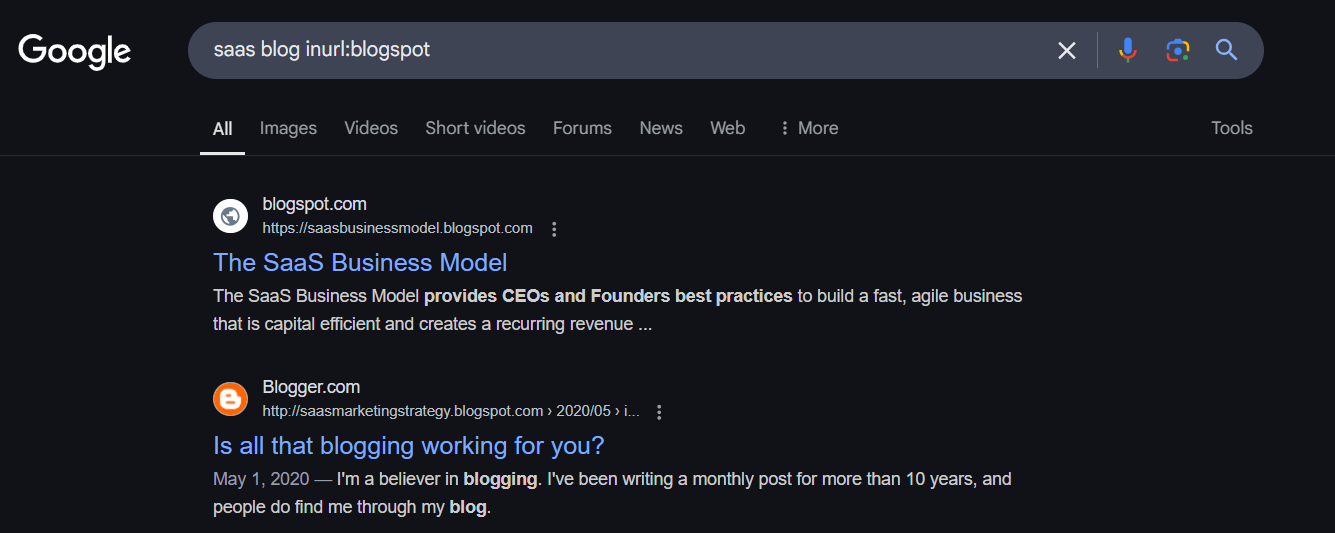
These searches help you find existing articles that mention SaaS products, making them ideal for niche edits.
If your competitors have secured niche edits, you can do the same. Use tools like Ahrefs, Semrush, or Moz to check where their backlinks come from.

Not all backlinks help your SEO. Before reaching out, make sure the site:
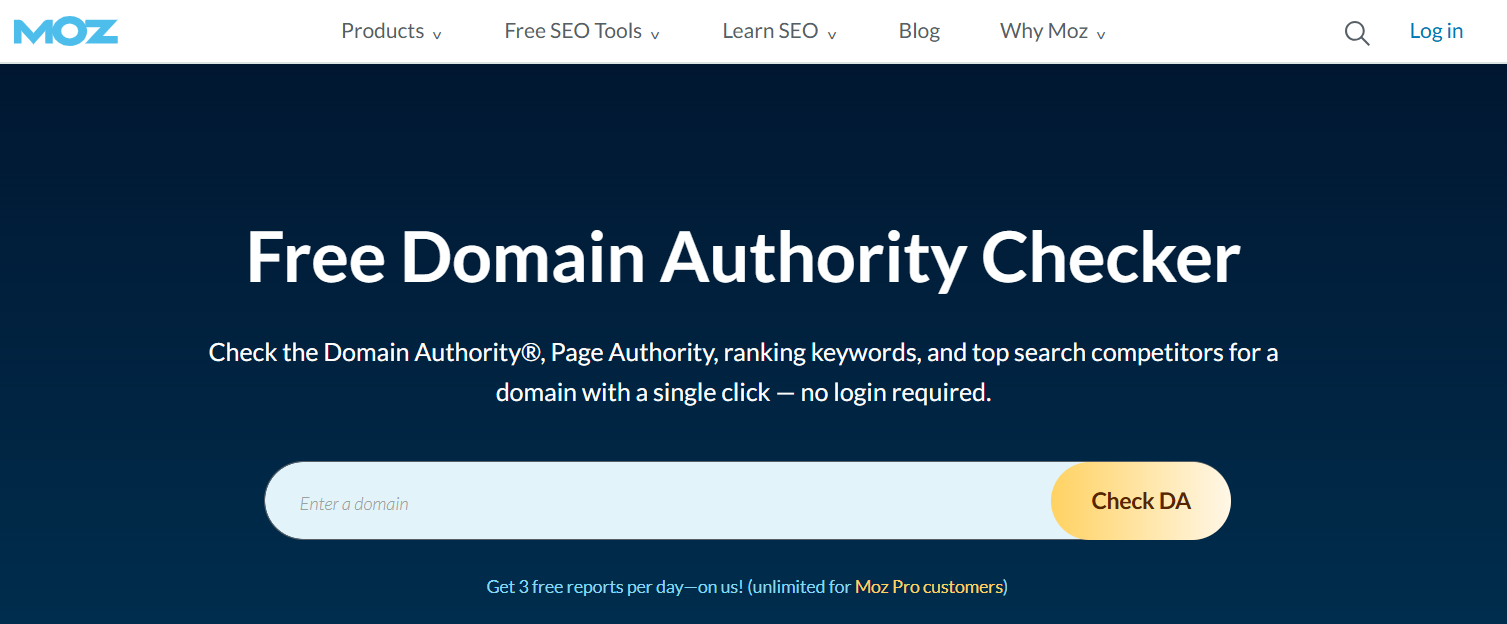
Focusing on high-authority, SaaS-focused blogs increases your chances of securing a valuable niche edit that benefits your search rankings.
Read also: Top SaaS Link Building Strategies to Boost Your Traffic and Authority
Once you find a relevant SaaS business’ website, the next step is to identify the right page for your niche edit. Link insertion to just any article won’t work. You need to find a strategic placement that benefits both you and the site owner.
Pages with outdated information, broken links, or declining traffic are prime targets for niche edits. You can find these using:

If a site owner sees that their page needs an update, they’re more likely to accept your niche edit.
Your link should fit naturally into the content. Some ideal types of pages include:
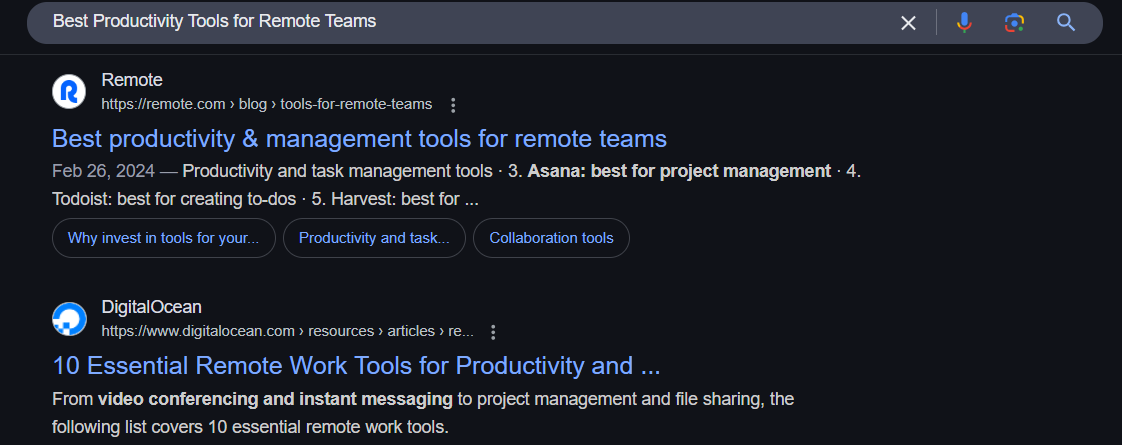
For example, if you run a project management SaaS, look for articles like “Best Productivity Tools for Remote Teams” and pitch your product as an additional resource.
The anchor text and surrounding content matter. A poorly placed link won’t help your SEO and might even get removed later. When requesting a niche edit:
A well-placed niche edit strengthens the page instead of just adding a link, making it more likely the site owner will approve your request.
Related: Effective SaaS Link Building Tips: Proven Strategies to Boost Your SEO in 2025
Once you’ve identified a relevant SaaS website and the right article for a niche edit, the next step is to reach out to the site owner or editor. Sending generic emails won’t get you far—your outreach needs to be personalized, concise, and focused on value.
Avoid mass emails or template-based outreach. Instead, write a short and direct email that shows you’ve actually read their content. Here’s a basic structure:
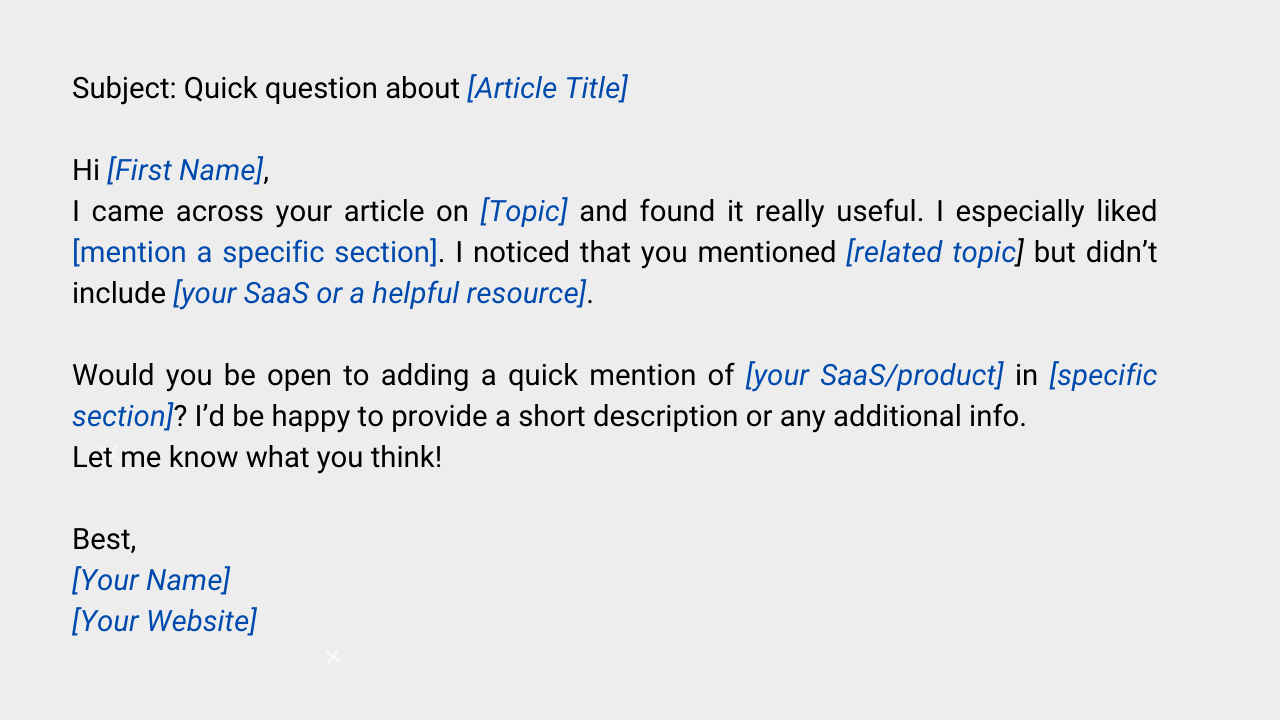
This keeps things short, friendly, and to the point. Site owners are more likely to respond if you respect their time.
Website owners won’t add your link just because you ask. You need to give them a reason to say yes. Here’s what you can offer:
If they see that adding your link improves their article, they’ll be more open to making the edit.
If you don’t hear back, send a polite follow-up in 5–7 days. Keep it simple:

If there’s still no response after two follow-ups, move on to the next person. Don’t spam.
Need your SaaS Digital PR strategy sorted? Book a 1-1 SaaS Content Marketing Strategy Call with Quoleady founder today.
Site owners receive dozens of link requests, so a simple “Can you add my link?” won’t work. Instead, make it easy for them to say yes by offering value.
Instead of just inserting a link, suggest a small content tweak that makes the article better. For example:
This way, your request feels like a content upgrade, not just a backlink grab.
Most editors won’t take the time to rewrite a paragraph for you, so do the work for them. Instead of just requesting a link, provide a ready-made snippet they can copy-paste into the article.
Example:

This makes it effortless for them to say yes.
A niche edit should fit naturally into the content. Avoid:
A well-placed niche edit adds value to the article, improves SEO, and builds trust with site owners—making future link opportunities easier to secure.
Not all niche edits are worth pursuing. Some backlinks can actually harm your SEO if they come from low-quality sites, link farms, or irrelevant content. Instead of chasing as many links as possible, focus on securing high-authority, more relevant sites, and natural placements that drive real results.
A site’s high Domain Authority (DA) isn’t the only factor to consider. Some high-DA sites have no real traffic or exist solely to sell backlinks. To avoid these, check:

Prioritizing websites with active traffic and engaged readers ensures that your niche edits contribute to long-term SEO growth.
Some sites openly sell niche edits, but Google is getting better at identifying paid links and devaluing them. Watch out for:
A handful of high-quality niche edits will always outperform dozens of low-quality links in terms of SEO impact.
Relying solely on niche edits isn’t a good strategy. Google favors natural, diverse link-building efforts, so combine niche edits with:
A well-rounded approach keeps your backlink profile strong and reduces the risk of Google penalties.
Securing a niche edit isn’t the final step—you need to track your backlinks and ensure they remain active over time. Links can get removed, changed, or devalued, so keeping an eye on them helps maintain your SEO performance.
Use tools like:
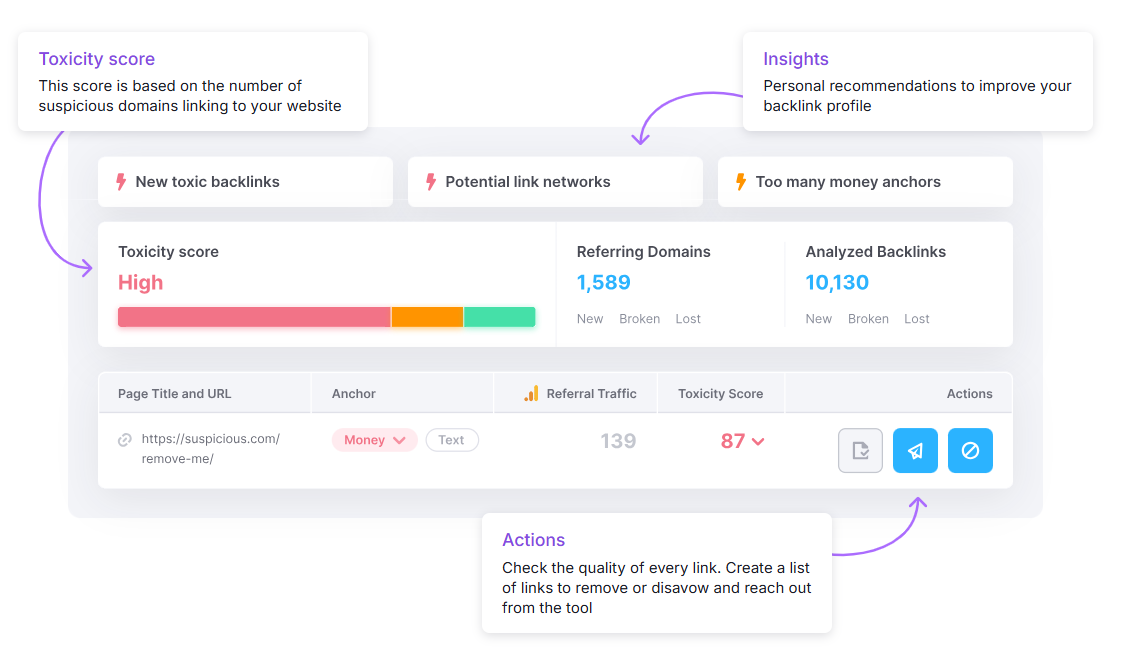
Set up automated alerts so you’re notified if an important backlink is removed.
Backlinks can disappear for various reasons like content updates, site migrations, or editorial changes. If this happens:
Instead of one-time link exchanges, aim to build ongoing partnerships with SaaS blogs. If a site owner sees you as a valuable contributor, they’ll be more likely to:
Link building isn’t just about getting backlinks—it’s about building connections that drive continuous growth for your SaaS business.
After you’ve secured your niche edit backlinks, tracking their impact is key. This helps you understand what’s working and where you might need to adjust your strategy. Here’s how to measure the success of your SaaS niche edit efforts:
Track referral traffic: Use Google Analytics to monitor the traffic coming from your newly acquired backlinks. Look for visitor numbers, session duration, and conversions from linked pages. This data shows you if the links are bringing in relevant, engaged traffic.
Monitor keyword rankings: Look for improvements in rankings for your target keywords and new keywords you’re ranking for that you weren’t before. Rising rankings often indicate that search engines are valuing your new backlinks.
Check domain authority growth: Use tools and metrics like Moz to track your domain authority over time. While it’s not a direct ranking factor, an increase in DA can signal that your overall link profile is improving.
Analyze conversion rates: Set up goals in Google Analytics to track how visitors from your niche edit backlinks convert. This could include free trial sign-ups, demo requests, or newsletter subscriptions.
Review backlink quality over time: Regularly audit your backlink profile using tools like Ahrefs or Majestic. Look for the number of referring domains, the authority of sites linking to you, and the relevance of the linking pages to your SaaS offering.
Adjust your approach based on data: Use the insights you gather to refine your niche edit strategy. Check if certain types of sites or content are driving more traffic, focus on getting more similar links. Also, check if some links aren’t performing well, investigate why and avoid similar opportunities in the future
Remember, link building is an ongoing process. Continuously measure, learn, and adjust to get the best results for your SaaS company.
While managing your own link building efforts can be rewarding, there are times when partnering with a specialized agency makes more sense. Here are some scenarios where outsourcing to a SaaS link-building agency could be beneficial:
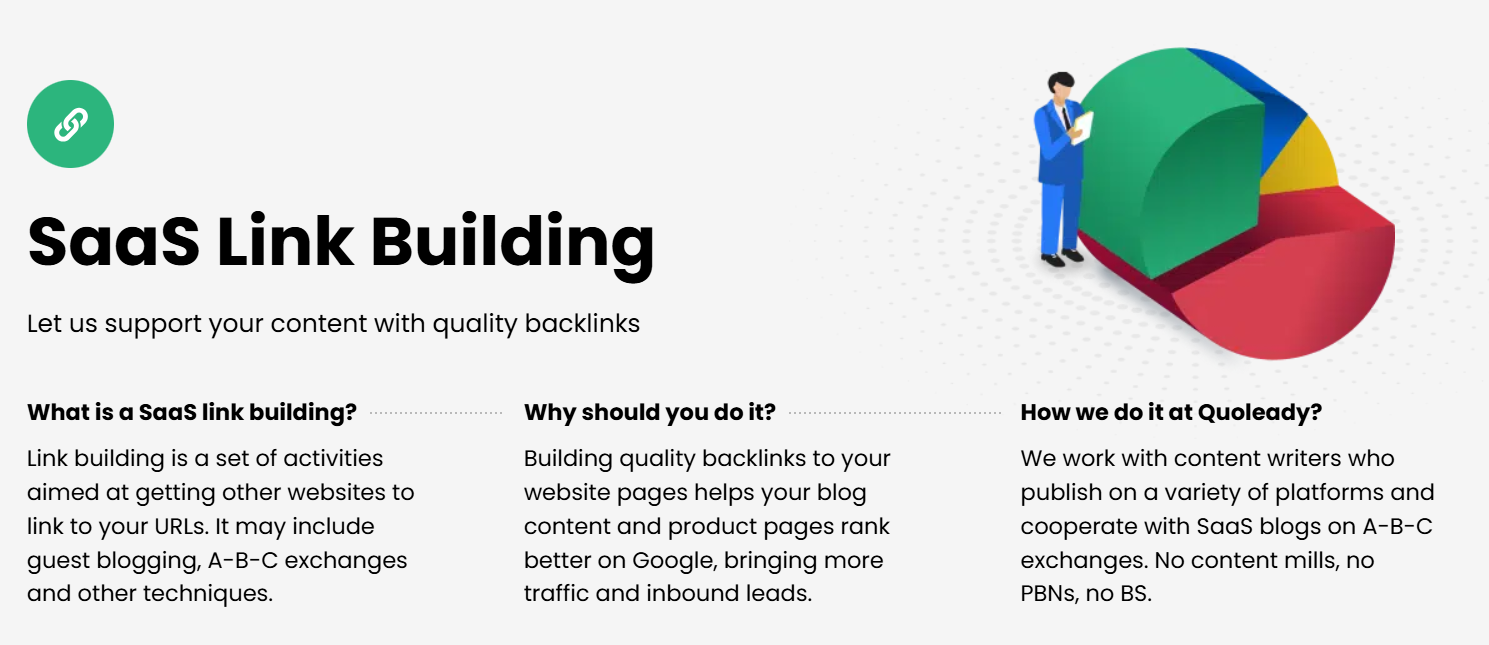
Lack of time or expertise: If your team is already stretched thin with other priorities, an agency can handle these tasks efficiently. SaaS link-building agencies have specialized knowledge and experience in securing high-quality backlinks within the software industry.
Need for scalability: If you’re looking to rapidly increase your backlink profile or target a large number of high-authority sites, an agency can scale and deliver your efforts more effectively. They have the resources and infrastructure to manage large-scale campaigns.
Focus on core business activities: By outsourcing link building, you can focus on product development and sales. This allows you to optimize your internal resources for core business activities.
Access to advanced tools and networks: Agencies often have access to advanced SEO tools and established networks within the industry. This can help you secure links from high-authority sites more efficiently than trying to build these relationships in-house
Building high-quality niche edit backlinks takes time, effort, and the right connections. Instead of managing outreach, negotiations, and link tracking on your own, let Quoleady do the heavy lifting for you.
We specialize in SaaS link-building strategies that drive real SEO results. Our team helps SaaS startups secure authoritative, relevant backlinks through niche edits, guest posts, and digital PR, without the hassle.
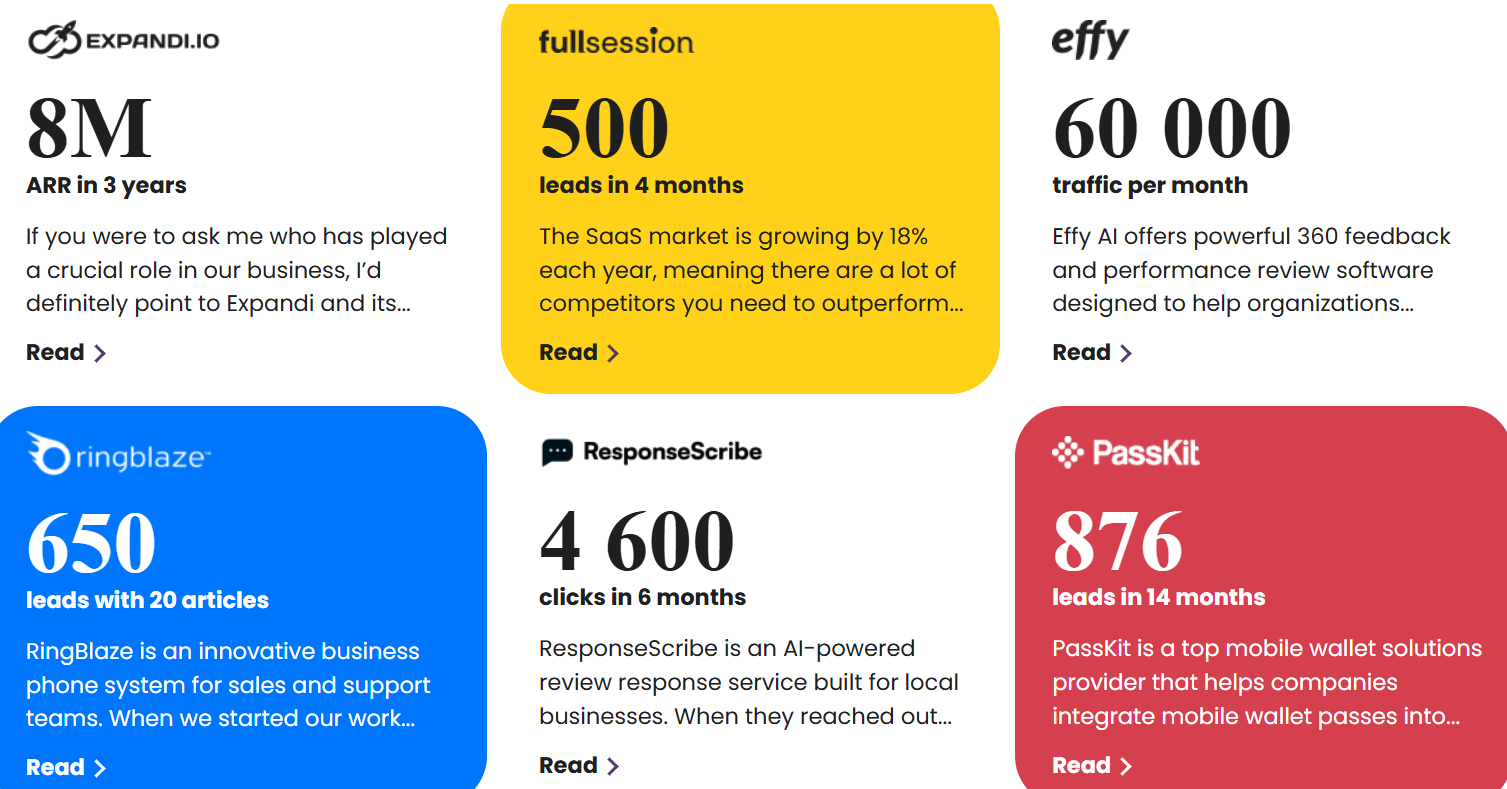
Here’s how we can help your SaaS business:
Ready to learn more? Visit our dedicated SaaS Link Building service page to explore how we can help you achieve your growth goals. Let’s build a stronger online presence for your SaaS company together!
Niche edits are links that are placed in an existing piece of content on another website. They are also known as link insertions. Niche edits differ from guest posting, where one writes a new article and gets published with a link back to one’s website. Niche edits are a type of link building method that involves requesting a link from an existing piece of content.
Niche edits offer high-quality backlinks by inserting links into existing, indexed content, leading to faster SEO gains than guest posts. They save time and resources while improving rankings, domain authority, and website credibility.
A niche edit is when you add a backlink to an existing article on another websites. It involve updating existing content, making them quicker and more natural for SEO. On the other hand, guest posts require creating fresh content from scratch, but they allow you to control the messaging and context of the link.
Anchor text is crucial for niche edit backlinks because it helps Google understand the context of your link and what the linked page is about. When requesting a niche edit, make sure the anchor text is natural, relevant, and varied, avoiding overly optimized keywords. This improves the SEO value of the link and makes it blend seamlessly into the existing content.
Editorial backlinks come from organic mentions in high-quality content. To earn them, create link-worthy content like data-driven studies or unique insights, and leverage digital PR by getting featured in SaaS roundups or industry news. Using HARO to respond to journalist queries can also help secure media backlinks. Building relationships with SaaS bloggers and pitching value-driven niche edits can lead to natural mentions. These backlinks are highly valuable for SEO because they come from trusted sources.
Let us know what you are looking to accomplish.
We’ll give you a clear direction of how to get there.
All consultations are free 🔥
